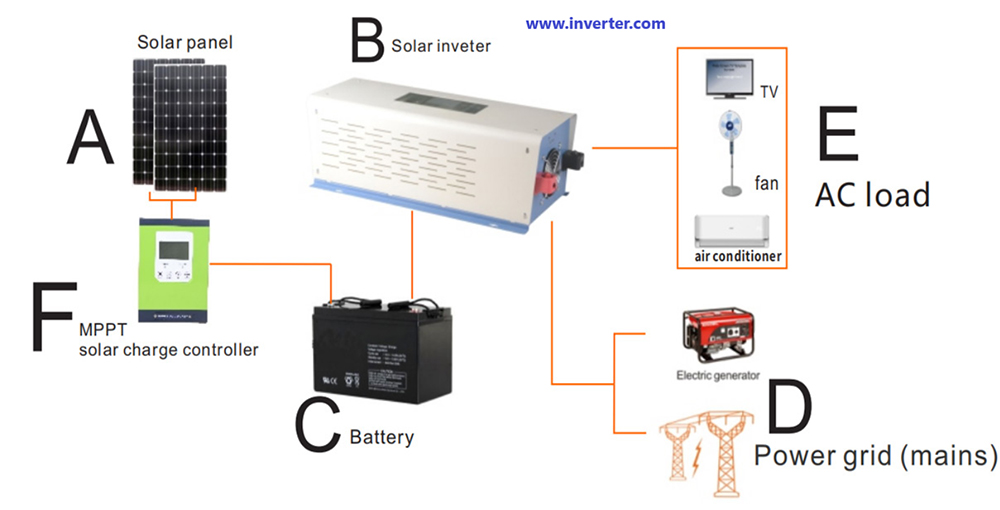When building an off-grid solar system, the inverter, as a key component, directly determines the overall system's operational efficiency and stability. Home Power Inverter will delve into eight tips for selecting an off-grid solar inverter, guiding you on how to comprehensively evaluate aspects such as output voltage and frequency, output power, and input DC voltage to find the product that best suits your needs.
Why choose an off-grid solar inverter?
With the growing environmental awareness and continuous advancement of renewable energy technologies, off-grid solar systems are becoming an important choice for many households and businesses. As the heart of an off-grid solar system, the inverter's role is to convert the direct current (DC) generated by solar panels into alternating current (AC) for use by homes or businesses. Therefore, choosing a high-performance, reliable inverter is crucial.
8 tips for selecting off-grid solar inverters
1. Matching Output Voltage and Frequency. When selecting an off-grid solar inverter, the first consideration should be whether the output voltage and frequency match your load devices. Different countries and regions have varying requirements for voltage and frequency, so it’s essential to understand the voltage and frequency needs of your load devices before purchasing an inverter. Ensure that the inverter can provide stable power output. Additionally, the inverter's output voltage and frequency should be adjustable to accommodate different load devices' requirements.
2. Determining Output Power. Output power is a critical parameter of an inverter that determines the number and type of load devices it can support. When selecting an inverter, you need to determine the required output power based on the total power consumption and operating time of your load devices. Generally, the inverter's output power should be slightly higher than the total power of the load devices to ensure stable operation under full load conditions. Moreover, the inverter should have some overload capacity to handle sudden load increases. For example, if your load is 5 kW, then the power capacity of your off-grid solar inverter should be at least 6000 watts. By ensuring the inverter has sufficient output power and overload capacity, you can maintain a stable and reliable power supply for your off-grid system.
3. Compatibility with Input DC Voltage. The output voltage of solar panels can be affected by factors like light intensity and temperature, so the inverter's input DC voltage range should be compatible. When choosing an inverter, you need to understand the output voltage range of your solar panels and select an inverter that matches this range. Typically, the inverter's input DC voltage range should cover the output voltage range of the solar panels to ensure proper operation under different lighting conditions.

4. Conversion Efficiency. Conversion efficiency is a crucial indicator of an inverter's performance. High-efficiency inverters can reduce energy loss and increase overall system efficiency. When selecting an inverter, you should look at its peak conversion efficiency and average conversion efficiency, opting for products with higher efficiency. Additionally, the inverter's cooling performance can impact its conversion efficiency, so it’s important to consider the cooling design and effectiveness.
5. Protection Features. Off-grid solar systems can encounter various abnormal conditions during operation, such as over-voltage, under-voltage, overload, and short circuits. Therefore, the inverter’s protection features are vital. When selecting an inverter, you should ensure it has over-voltage protection, under-voltage protection, overload protection, and short-circuit protection to guarantee safe system operation. Some high-end inverters also offer intelligent protection features, such as temperature protection and fan failure protection, enhancing system stability and reliability.
6. Cooling Performance. Inverters generate heat during operation, and poor cooling can lead to increased temperatures, affecting performance and lifespan. When selecting an inverter, you should consider its cooling performance, including the cooling design, the power and number of cooling fans, and the material and area of the heat sinks. In general, inverters with good cooling performance can better adapt to high-temperature environments, ensuring stable system operation.
7. Brand and After-Sales Service. Brand and after-sales service are crucial factors when choosing an inverter. Products from well-known brands usually offer better quality and performance assurance, while comprehensive after-sales service can provide timely technical support and maintenance during use. Therefore, when selecting an inverter, you might prefer products from reputable brands and learn about their after-sales service policies.
8. Compatibility and Expandability. An off-grid solar system is a complex system composed of multiple components. Therefore, when choosing an off-grid solar inverter, you need to consider its compatibility with other components, including interface types and communication protocols. Expandability is also important if your system requires future expansion or upgrades. In this case, you should select an inverter with good expandability to meet future needs.
Choosing the right off-grid solar inverter is a crucial step in building an efficient and reliable off-grid solar system. By clearly considering factors such as output voltage and frequency, output power, input DC voltage, conversion efficiency, protection features, cooling performance, brand, and after-sales service, as well as compatibility and expandability, you can select a high-performance, reliable inverter that provides stable power output for your off-grid solar system. Hopefully, these eight tips will help you make an informed decision during the selection process, enabling you to create an efficient and sustainable solar power system.
